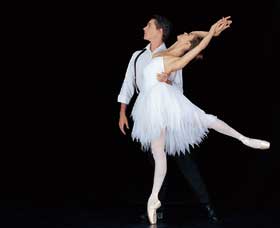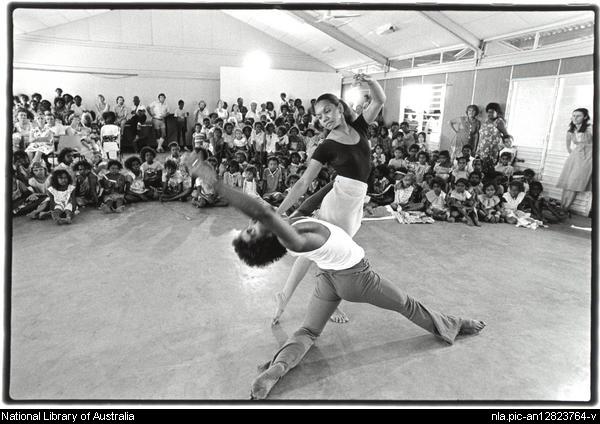-
Ballet styles:
-
Classical Ballet
Most formal style which adheres to traditional ballet technique. Variations relate to area of origin, such as Russian ballet, French ballet and Italian ballet. The most well-known styles of ballet are the Russian Method, the Italian Method, the Danish Method, the Balanchine Method or New York City Ballet Method, and the Royal Academy of Dance and Royal Ballet School methods created in England.
-
Neoclassical BalletUses traditional ballet vocabulary but is less rigid than the Classical Ballet where dancers often dance at more extreme tempos and perform more technical feats. Spacing in Neoclassical Ballet is usually more modern or complex than in Classical Ballet. Although organization in Neoclassical Ballet is more varied, structure is a defining characteristic of Neoclassical Ballet.
-
Influenced by both classical ballet and modern dance taking its technique and use of pointe work from Classical Ballet, although it permits a greater range of movement that may not adhere to the strict body lines set forth by schools of ballet technique. Many of its concepts come from the ideas and innovations of 20th century modern dance, including floor work and turn-in of the legs. George Balanchine is often considered to have been the first pioneer of Contemporary Ballet through the development of neoclassical ballet.
-
Romantic ballet
Defined primarily by an era in ballet in which the ideas of Romanticism in art and literature influenced the creation of ballets. The era occurred during the early to mid 19th century primarily at the Théâtre de l'Académie Royale de Musique in Paris and Her Majesty's Theatre in London. The era is typically considered to have begun with the 1827 début in Paris of the ballerina Marie Taglioni in the ballet Le Sicilien, and to have reached its zenith with the premiere of the divertissement Pas de Quatre staged by the Ballet Master Jules Perrot in London in 1845. The Romantic Ballet had no immediate end, but rather a slow decline. Arthur Saint-Léon's 1870 ballet Coppélia is considered to be the last work of the Romantic Ballet.
Many of the works of the Romantic Ballet focused on the conflict between man and nature, society and the supernatural, while others focused on bringing the exotic worlds of far off lands and national character into the ballets of the period. The era gave way to decline of the male dancer, while ballerina took centre stage. Furthermore, the development of pointework, although still at a fairly basic stage, profoundly affected people's perception of the ballerina. Many lithographs of the period show her virtually floating, poised only on the tip of a toe. This idea of weightlessness was capitalised on in ballets such as La Sylphide and Giselle and the famous leap apparently attempted by Carlotta Grisi in La Péri.
Other features which distinguished Romantic Ballet were the separate identity of the scenarist or author from the choreographer and the presence of specially written music as opposed to a pastiche typical of the ballet for the late 18th and early 19th centuries. The invention of gas lighting enabled gradual changes and enhanced the mysteriousness of many ballets with its softer gleam. Illusion became more diverse with wires and trap doors being widely used.

Ballet technique - French ballet
- Russian Vaganova method
- Italian Cecchetti method
-
First National Preventive Health Research Programme YELP Holistic First Business Plan YELP Holistic First Business Plan Defined Terms SWOT Analysis Executive Summary Deliverables And Costs Snapshot Page To 10 Benchmark Techniques Defined Terms for Five YELP Business Plans
Second National Preventive Health Research Programme
First BTAAP Business Plan Bohémian Teenagers Show Choir Programme Defined Terms BTSCP
Second BTAAP Business Plan Bohémian Teenagers Symphony Orchestras Programme Defined Terms - Bohémian Teenager Symphony Orchestra Programme
Third BTAAP Business Plan Bohémian Teenager Ballet & Modern Dance Programme Defined Terms BTB&MDCP
Styles Of Dance means:
1. Ballet
2.
Modern
Dance
Developed in the early 20th century. Although the term Modern Dance has also
been applied to a category of 20th Century
ballroom dances, Modern Dance as a term usually refers to
20th century Concert Dance.
|
The multiplicity of genres makes the term Contemporary Dance’ redundant, where anything seems possible and orthodoxies, even recent ones, need no longer constrain creativity. are built upon the foundations laid by Modern Dance and form part of the greater category of 20th century concert dance. Where as Postmodern dance was a direct and opposite response to Modern dance, Contemporary dance draws on both modern and postmodern dance as a source of inspiration. |
 |
4. Corroboree
Ceremonial meeting of Australian Aborigines. The word was coined by the European settlers of Australia in imitation of the Aboriginal word caribberie. At a corroboree Aborigines interact with the Dreamtime through dance, music and costume. Many ceremonies act out events from the Dreamtime. Many of the ceremonies are sacred and people from outside a community are not permitted to participate or watch.
In the northwest of Australia, corroboree is a generic word to define theatrical practices as different from ceremony. Whether it be public or private, ceremony is for invited guests. There are other generic words to describe traditional public performances: juju and kobbakobba for example. In the Pilbara, corroborees are yanda or jalarra. Across the Kimberley the word junba is often used to refer to a range of traditional performances and ceremonies.
Corroboree and ceremony are strongly connected but different. In the 1930s Adolphus Elkin wrote of a public pan-Aboriginal dancing "tradition of individual gifts, skill, and ownership" as distinct from the customary practices of appropriate elders guiding initiation and other ritual practices (Elkin 1938:299). Corroborees are open performances in which everyone may participate taking into consideration that the songs and dances are highly structured requiring a great deal of knowledge and skill to perform.
Corroboree is a generic word to explain different genres of performance which in the northwest of Australia include balga, wangga, lirrga, junba, ilma and many more. Throughout Australia the word corroboree embraces songs, dances, rallies and meetings of various kinds. In the past a corroboree has been inclusive of sporting events and other forms of skill display. It is an appropriated English word that has been reappropriated to explain a practice that is different to ceremony and more widely inclusive than theatre or opera.
|
The Aboriginal Islander Dance Theatre (AIDT) was set up as an ongoing performing group in 1976. It was originally made up of young people participating in Careers in Dance, a full-time dance training course for Aboriginal and Islander students initiated in 1975 by the Aboriginal Arts Board and led by founding teacher Carole Johnson. The group developed to include teachers, graduate students and advanced students of what eventually became NAISDA (National Aboriginal and Islander Skills Development Association) College, and frequently invited guest artists to perform with it. AIDT became a professional performing group in 1988 and was launched as a company in 1991 under the artistic directorship of Raymond Blanco. The AIDT repertoire was based on traditional and contemporary dance with its early promotional material stressing the modern Aboriginal/Islander identity. Indigenous tutors such as Janet Munyarryun, Veronica Munyarryun, Larry Gurruwiwi, Michael Warusam and Cedric Waia taught traditional choreography and Dorothea Randall and Rosalyn Watson played an important role in contributing Indigenous choreography to end of year productions in the 1980s. Over the years other Indigenous choreographers would include David Gulpilil, Dell Sebasio, Stephen Page and Bernadette Walong. Non-Indigenous choreographers who worked with the company include Ronne Arnold, Robina Beard, Elisabeth Burke and Pierre Thibaudeau, Kate Champion, Kai Tai Chan, Karen Kerkhoven, Chrissie Koltai, Paul Saliba and Cheryl Stock. From 1991 AIDT repertoire included Jedda (1991), Maralji (1991), Yirrkala (1991), Colours (1993), Gelam (1993), On the Spot (1994), and Sanctum (1994). AIDT's first international tour was in 1977 participating in the African and Black World Festival of Arts and Culture in Nigeria. Its first international tour as a larger company was in 1988 when AIDT performed in Finland and Germany. Later tours took the dancers throughout Australia and internationally to Asia, Europe and the Americas. |
 |